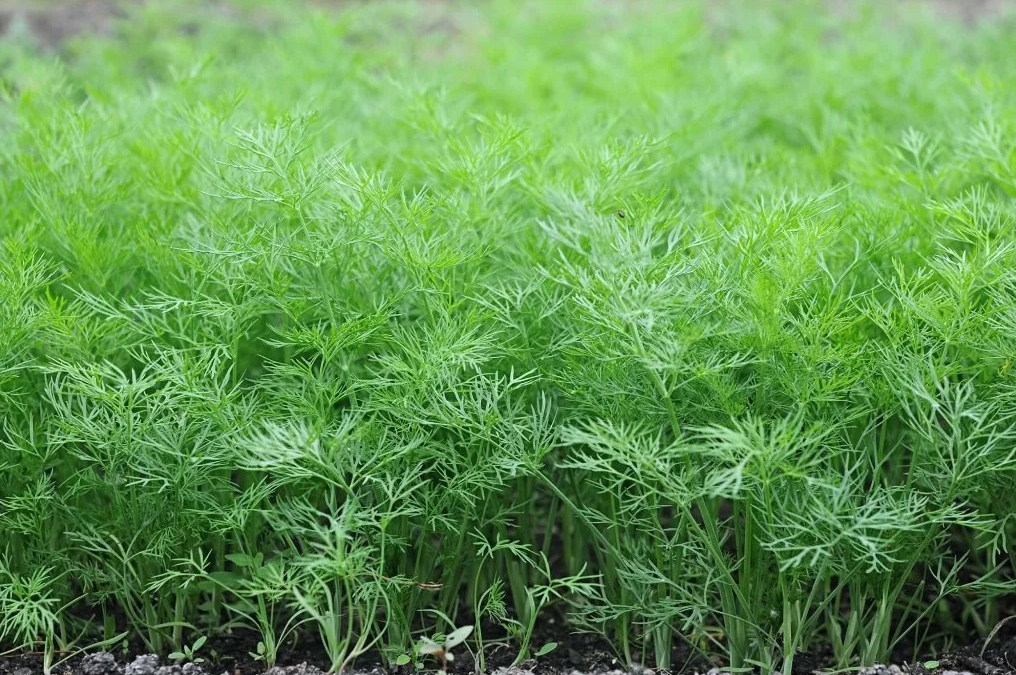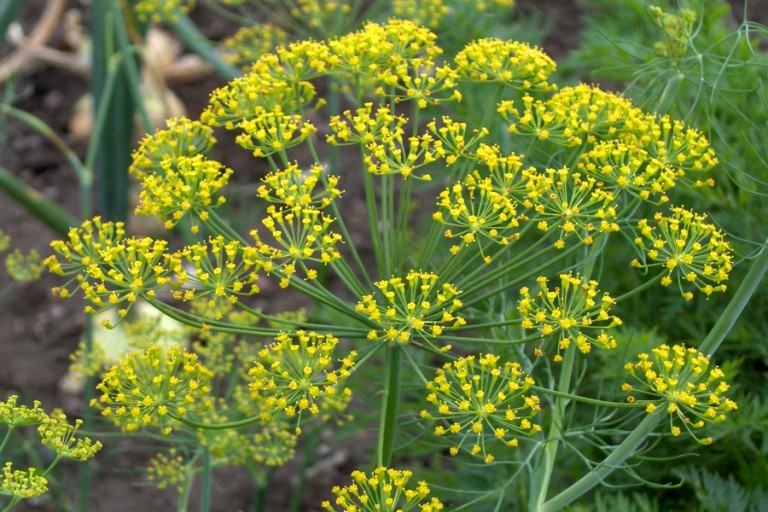 It is good to have delicate dill greens on the table daily; it stimulates the appetite with one look. But not everyone manages to grow an odorous annual plant in their country house. Many summer residents do not know how to properly sow seeds in order to get friendly seedlings.
It is good to have delicate dill greens on the table daily; it stimulates the appetite with one look. But not everyone manages to grow an odorous annual plant in their country house. Many summer residents do not know how to properly sow seeds in order to get friendly seedlings.
Content
We sow dill in the winter
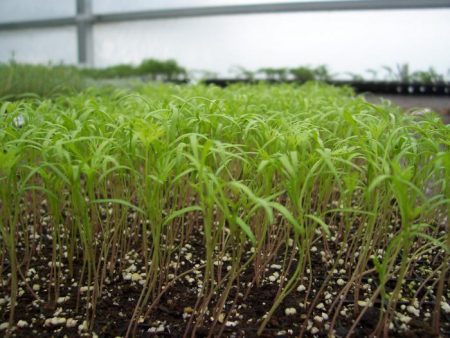 Winter sowing is the easiest and most reliable way to get early greens. First you need to choose a good place for the beds. It should be lighted up by the sun in the summer in moderation; in winter, snow should linger on it.
Winter sowing is the easiest and most reliable way to get early greens. First you need to choose a good place for the beds. It should be lighted up by the sun in the summer in moderation; in winter, snow should linger on it.
The soil must be dug deep enough (25 cm), add humus or compost to it. On at least 1 m² of bed, add at least ½ bucket of organic matter. If the soil is acidic (pH <5.5), add dolomite flour (350 to 500 g / m²), chalk (100 to 300 g / m²) or ash (200 g / m²).
When sowing seeds before winter, do not soak the seeds, sow dry.
The prepared ridge is inoculated 2 weeks before the onset of frost. On the bag with seeds, the consumption rate per square meter is indicated, it is increased by at least 25%. Furrows are placed at intervals of 15 cm; they are covered with a layer of 3-4 cm. If winters with little snow are mulched.
As soon as the snow falls in the spring, the mulch is removed. After warming the soil to 5 ° C, the seeds grow. Young shoots are not afraid of cooling. Seeds in winter undergo a natural stratification, so they sprout together.
Dill in the greenhouse
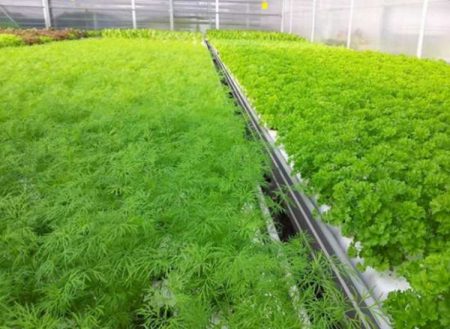 Dill can be planted in a carbonate greenhouse at the end of winter. Prepare the soil in the fall. Remove residual roots, dig, add humus, smooth the surface with a rake. Pour a mixture of garden soil and humus into bags or buckets, it will come in handy in the spring. Store in a greenhouse or take bags to a warm barn.
Dill can be planted in a carbonate greenhouse at the end of winter. Prepare the soil in the fall. Remove residual roots, dig, add humus, smooth the surface with a rake. Pour a mixture of garden soil and humus into bags or buckets, it will come in handy in the spring. Store in a greenhouse or take bags to a warm barn.
In winter, apply snow to the greenhouse, cover it with the entire surface of the ridge. Sow in February. Scatter seeds randomly, sprinkle with 5-7 cm thick snow on top. With the advent of spring, it will melt, while moistening the soil well. The surface of the ridge should be mulched with earth prepared from autumn (2-3 cm).
Water the garden regularly before and after emergence.
Cover plantings with a film to reduce moisture evaporation, accelerate seed germination. They will begin to hatch when the soil warms up to 4-5 ° C. You can accelerate seed germination using infrared lamps if the greenhouse is electrified. In this case, after 2-3 weeks you can cut the first crop of greens.
Sparging seeds
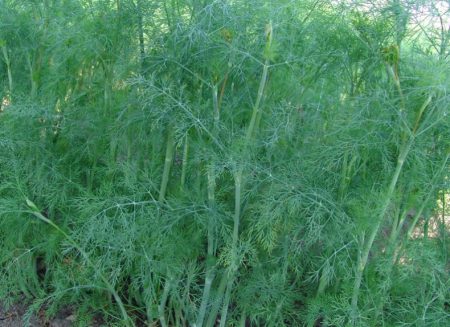 Dill seeds sprout for a long time due to the high concentration of essential oils in the shell. To accelerate the emergence of seedlings, many gardeners soak them in hot water, dry and sow. Green sprouts appear after 7-10 days.
Dill seeds sprout for a long time due to the high concentration of essential oils in the shell. To accelerate the emergence of seedlings, many gardeners soak them in hot water, dry and sow. Green sprouts appear after 7-10 days.
Sparging of seeds accelerates the emergence of seedlings by almost 2 times, sprouts appear 5-7 days after planting. By bubbling is meant the impact on the seeds with water and oxygen, for the treatment it will be required:
- water;
- bank;
- compressor (aquarium);
- tip for compressor.
Pour the seeds into a jar, fill them with water at room temperature. The diffuser of the compressor is lowered into the jar, the compressor itself is adjusted, turned on. Air bubbles enrich the water with oxygen, wash essential oils from dill seeds. The processing time is 12-20 hours.
Fold the seeds onto a cotton cloth, dry them a bit and start planting. In the spring, the first sowing is carried out in April 10-15. The soil at the time of planting should warm up to 5-7 ° C. Mark the furrows at a distance of 15-20 cm from each other, well water.Sprinkle the seeds with garden soil mixed with humus (1: 1) or compost.
Dill does not need mineral fertilizing if organic matter (compost, humus, peat) is added to the soil.
The ridge is covered with a film so that the soil does not dry out, after the appearance of the first shoots, it is removed. Dill care is quite simple:
- watering;
- weeding;
- loosening row spacings.
Watered often enough, if the soil is constantly wet, does not dry out, then the greens are more juicy, the yield per unit area is greater. After 2-3 weeks, re-sowing is carried out. During the season, dill can be sown several times. August sowing can be used for freezing for the winter.
How to sow dill in the summer - the advice of an experienced gardener
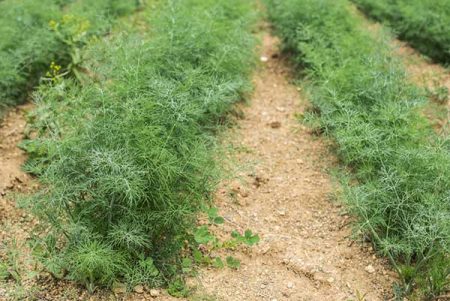 It is easiest to plant dill in early spring. There is a lot of moisture in the soil after winter, it rises well and quickly, requires a minimum of maintenance. In summer, beds are freed after early crops, but the heat begins, the earth dries.
It is easiest to plant dill in early spring. There is a lot of moisture in the soil after winter, it rises well and quickly, requires a minimum of maintenance. In summer, beds are freed after early crops, but the heat begins, the earth dries.
Dill, planted in hot land, does not emerge well, its sprouts are weak, thinned. There is a way out, stratification will correct the situation. To conduct it, you need to prepare:
- sand ½ bucket;
- dill (seeds) 1 liter jar;
- water.
Seeds must be evenly mixed with sand, pour water. Sand should be moderately moist, water should not drip from it. The bucket should be put in the shade, after 4 days, mix and pour the contents. After 3-4 days, when the seeds bite, proceed to planting.
Dill emerges faster if the ridge is covered with agrofibre, and when irrigated it is not removed.
Sow into deep grooves (depth 5 cm) to maintain a distance of 20 cm between them. Make furrows with a chopper. Sow seeds densely, after falling asleep with the earth with a layer of 4-5 cm, it is good to water. The mistake is made by gardeners who fall asleep dill seeds with a thin layer of 10-20 mm. In the heat, the soil dries instantly after irrigation, so the seedlings are rare and weak.
We grow dill on the balcony
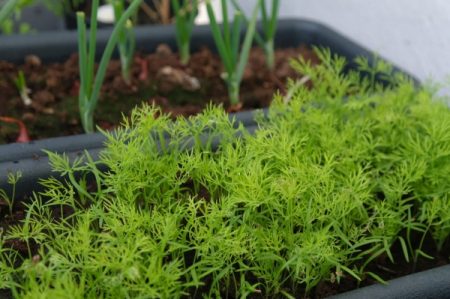 You can grow dill on greens without giving. Window, loggia, balcony - places where you can place a box of greenery. Everything you need to grow dill can be bought in a store for gardeners:
You can grow dill on greens without giving. Window, loggia, balcony - places where you can place a box of greenery. Everything you need to grow dill can be bought in a store for gardeners:
- plastic container;
- universal soil for vegetables;
- growth stimulant;
- seeds.
Dill buy several varieties with different ripening dates (early, mid-ripening, late). Each variety can be planted in a separate box. Treat the seeds before planting with a growth stimulator. The processing process is described in the instructions for use.
Fill the boxes with soil, pour. Scatter seeds evenly over the soil surface, sprinkle with a soil layer of 1-2 cm. Moisten the topsoil from the sprayer, tighten the boxes with cling film. Regularly moisten the soil before emergence.
Harvesting and processing dill
For freezing, young plants grown to 5-7 cm are used. The collection is carried out selectively, cutting off individual bushes or the entire dill at once. In the second case, the ridge can be used for repeated crops. Dill is dried or frozen. There are more vitamins in frozen greens than in dried greens.
Not a problem if you want to grow fresh herbs, but there is no experience. The main thing is to choose a good variety and properly prepare the soil. Gribovsky dill, Umbrella, Amazon, Richelieu, Alligator received good reviews.

